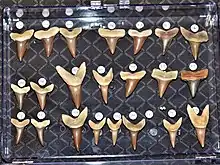Macrorhizodus
Macrorhizodus is an extinct genus of Mackerel shark which lived during the early to middle Eocene epoch of the Paleogene period. It is often considered ancestral to Isurus and sometimes considered part of it. Macrorhizodus is also likely ancestral to Cosmopolitodus. It seems to be related to Isurolamna. It is known from isolated teeth and vertebral centra as well as at least two associated dentitions.[1] It is an incredibly widespread shark, known from every continent except Australia. This includes a report from Antarctica.[2]
| Macrorhizodus Temporal range: | |
|---|---|
 | |
| Macrorhizodus praecursor from the Eocene of Kazakhstan | |
| Scientific classification | |
| Domain: | Eukaryota |
| Kingdom: | Animalia |
| Phylum: | Chordata |
| Class: | Chondrichthyes |
| Order: | Lamniformes |
| Family: | Lamnidae |
| Genus: | †Macrorhizodus Glikman, 1964 |
Species
The genus is composed of the following species:
| Species | Notes | Images | Ref. |
|---|---|---|---|
| Macrorhizodus nolfi | This is an early Eocene (Ypresian) species. It is well known from the London Clay of England, the Aktulagay Formation of Kazakhstan, and other places in Eurasia.The species is notably absent in contemporary formations in North America. |  Macrorhizodus nolfi from England |
[3] |
| Macrorhizodus praecursor | This species is from the mid to late Eocene. Some authors restrict this species to the Lutetian stage, while other prefer to lump it with the next two. It is known from the lower Santee Limestone Formation of South Carolina, the Lutetian of Kazakhstan, the Piney Point Formation of Virginia, and other Lutetian localities. |  Macrorhizodus praecursor from Kazakhstan |
[1] |
| Macrorhizodus americana | This species is limited to the Bartonian. It is sometimes lumped with M. praecursor. It is best known from Kazakhstan, but has been found in other formations. It is known from the upper Santee Limestone Formation of South Carolina. |  Macrorhizodus americana from Kazakhstan |
[4][1] |
| Macrorhizodus falcatus | This species is limited to the Priabonian. It is sometimes lumped with M. praecursor. It is common in the Samlat formation of Dakhla, Morocco. |  Macrorhizodus falcatus from Morocco |
[4] |
This genus appears to have undergone anagenesis, making it difficult to draw lines between species. Some authors prefer to lump and others to split. The early Oligocene species Macrorhizodus flandricus ascribed to this genus now usually considered to be a synonym of Isurus desori, sometimes styled Isurus desori flandrica. However, I. desori might itself be a junior synonym to I. oxyrhincus. This confusion stems from the proximity of Macrorhizodus to Isurus.[1]
References
- Bourdon, Jim (2007). "Macrorhizodus". Elasmo: The Life and Times of Long Dead Sharks.
- Cione, Alberto L.; Reguero, Marcelo (Jan 1994). "New records of the sharks Isurus and Hexanchus from the Eocene of Seymour Island, Antarctica". Proceedings of the Geologists' Association. 105 (1): 1–14. doi:10.1016/S0016-7878(08)80134-4.
- King, C., Iakovleva, A., Steurbaut, E., Heilmann-Clausen, C., & Ward, D. (2013). The Aktulagay section, west Kazakhstan: a key site for northern mid-latitude Early Eocene stratigraphy. Stratigraphy, 10(3), 171-209
- Everaert, S. Een bijzondere vondst van ‘Isurus’ flandricus (Leriche, 1910) uit het Rupeliaan (Oligoceen) van Vliermaal (Limburg, Vlaanderen) en enkele beschouwingen bij deze soort.